15 minute read
WARNING: Mentions of suicide
Anna Ruschen (pronounced Ruskin), my 3 x great grandmother, was born on the 28th September 1850 in Babow, Prussia. Anna was the mother of Emma Bennett who married Carl Andriske. Their daughter Unita then had Charlie, my maternal grandfather. Charlie was 28 when Anna died, so whilst Anna lived a long way from Coonamble, it is probable that he knew her and may have met his great grandmother, although I am unaware of any family stories handed down about Anna. The information in this story has come from official records and from descendants of Anna’s other children.
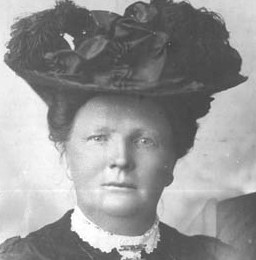
Anna’s family were Wends, an ethnic minority today better known as Sorbs. They lived in an area called the Spreewald, west of Cottbus and about 100kms south of Berlin, in what was then the Kingdom of Prussia but from 1871 became Germany. The Spreewald is an area of outstanding beauty, with forests, wetlands and canals which attract many visitors today. Anna’s father, Martin Ruschen, applied to immigrate from Prussia in the mid-1850s. His first wife, Liese (or Elizabeth) Kohl had died some years previously, leaving Anna and her younger sister Maria without a mother. Martin remarried to Johanne Christiane Gurkan, known also as Anna.
Martin, step-mother Anna, 7 year old Anna and 5 year old Maria left their home in Naundorf in 1858 and travelled to Hamburg. The family were originally listed as emigrating to the United States, where a great many of their fellow Wends ended up, mainly in states like Texas. The Ruschen family however, were sent to South Australia. This state had only been settled some twenty years prior, with Germans arriving just two years later. The Ruschen family’s background in Prussia and their journey to South Australia and later, New South Wales, will be told in a separate blog.
Arriving at just 7 years old, Anna would have been quick to adapt to her surroundings, learning English in addition to German and her native tongue of Lower Sorbian, now an endangered language. We know from court records that her father spoke very limited English, so with Anna being tri-lingual, her language skills would have been invaluable to him. It would also allow her to integrate more easily into the heavily British & Irish influenced culture. She would inevitably inhabit a Christian and a Lutheran world, seamlessly drifting between the two religions throughout her life.
Anna’s next sibling, half-brother Heinrich (later called Henry) was born at sea, then four more brothers followed. Martin Ruschen made his living as a farmer and the family lived in the Barossa Valley, north of Adelaide. However, high land prices and poor soils were a great disappointment to many Germans and in 1867, the family of (now) nine gathered their belongings and made the trek across to New South Wales by horse and wagon. Taking about six weeks, Anna, now aged 16, would have been a great help to her step-mother Anna, who had a newborn baby to care for during the long, arduous journey. With land purchase made easy by the NSW government, many German families travelled to a new homeland, one they made several kilometres north of Albury. Originally called Dight’s Forest, the town was renamed Jindera, (possibly a Wiradjuri word), and became a German enclave.
Anna and her family’s arrival in Jindera came at an interesting time in the history of the area. Just prior to the arrival of at least 80 German families, there had been a gold rush in the area. In the mountains between Jindera and Albury, in an area called The Black Range, gold was discovered and by 1865 the area had hundreds of both European and Chinese gold miners. Amongst those tempted by the possibilities brought by the gold discovery, was an enterprising young businessman called John Barlow. He set up a shop called The Prospector’s Store and soon after, The Riverina Hotel. Another young man by the name of William Bennett had also seized the opportunity to seek out his fortunes far from home. Landing from England to the Riverina district in the mid to late 1860s, William’s path would soon cross with the newly arrived Germans and John Barlow.
Meanwhile, The Black Range gold diggings was already drying up, leaving business owners with little choice but to cut their losses and move onto the next profitable venture. John Barlow sold off his properties at The Black Range and moved operations up through the Jindera Gap to the new township around 1868. With the German settlers focused on farming, there was a need for enterprising businessmen to supply goods to the new arrivals. John Barlow would make the town of Jindera his home and flourish there. The goldfields of The Black Range later became a Chinese market garden and a place of orchard growers before converting to a residential suburb of Albury, named Lavington. The house I purchased in 2021 sits on this very land so the story of this area is extra personal to me. Sadly, I’ve yet to discover any gold in my backyard.
By 1869, two years after arriving, Anna Ruschen had become a fine young woman of the district. She caught the eye of the Englishman William Bennett and in possible defiance of her father, was married to William in the Anglican church, St Matthews, in Albury on the 18th October 1869, just after her 19th birthday. There were no ages, birthplaces or parents recorded on the marriage certificate, and as Anna was under the age of consent, she would have declared she was 21 or more so she could marry without her father’s permission. It may also have been the case that a Lutheran pastor was not available to marry the couple or William chose his religion over Anna’s. The young couple moved to the Belvoir area (later called Wodonga) on the south side of the Murray River, where their first child, daughter Emma Maria, my 2 x great grandmother, was born in September 1870.
But with family 20-odd miles away, William and Anna soon moved to Jindera, where their second son William was born in 1872. Another son, George Henry was born in early 1875, followed by two daughters, Lydia Bertha in 1877 and Anna Louise Caroline in 1879. Another son Arthur Edward was born in 1881 and then Charles Reinhold Martin arrived, in January 1884. With seven children to feed, William and Anna looked for business opportunities within their community. In January 1883, with William doing well for himself, he purchased a selection of land at Moorwatha, just west of Jindera. The 60 acres would have allowed him to support his family comfortably. William Bennett then took over as licensee of the Jindera Mill Hotel (owned by August Haberecht) in early 1884, cementing himself in the centre of the small community. Some members of my Andriske family also moved from Geelong to Jindera around this time, with my ancestor Carl Andriske’s sister Louisa marrying a German man, Ernest Schulz.
Jindera was now a thriving and cohesive mix of German and non-German residents. But the community would be sorely tested in April 1884 when Ernest Schulz died, leaving Louisa a widow at just 31. His cause of death was determined as blood poisoning, contracted after performing an autopsy on his horse without proper protection. Then in July, William Bennett was accused of horse stealing. It was never determined if William was guilty or not, because the shame he felt it brought to himself and his family weighed heavily on his mind. He consumed arsenic, dying an agonising death and leaving Anna to bring up their seven children alone. The Jindera community rallied around Anna, particularly her fellow publicans, including John Barlow, despite having his own troubles. Just two months after William’s death, John’s wife Elizabeth Barlow died after a long illness. No doubt in the difficult months that followed, John and Anna leaned on each other for support. John also knew the publican game well and at the time was the owner of the rival Forest Hotel in Jindera.
The story of William Bennett and his unfortunate demise can be read here; Accusations and Arsenic; the untimely death of Mr Bennett – Quirky Characters
Just two months after William’s death, Anna applied to the licencing board to carry on as publican of the Mill Hotel, which was granted. In September probate was granted on William’s will, with the estate worth 638 pounds. Then in late October, the following notice appeared in the local paper.
Mrs Bennett, the widow of Mr Bennett of Jindera, who it will be remembered died by his own hand a few months ago, received last week a cheque for 300 pounds, the amount for which his life was insured in the Colonial Mutual Assurance Office. The policy, we understand, was only taken out in May last, and no more than one premium had been paid.
The money from the estate helped Anna pay for one of the largest headstones in Jindera cemetery, which still stands proud today.
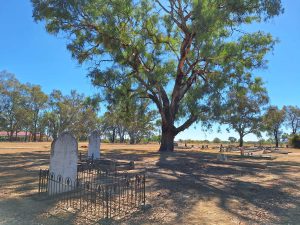
Carrying on with her responsibilities regardless, six months later Anna posted a notice in the Albury Banner advertising a Sports Day at the Jindera Mill Hotel for Easter Monday 1885. She was now ‘Anna Bennett, Proprietress of the Mill Hotel’. John Barlow acted as one of the race stewards. The day was a great success with a concert also raising money that went to the benefit of the Albury Hospital. The pressure to raise a family and act as landlady of a pub would have been immense and so it was by June that Anna had given over the lease of the Mill Hotel to a Mr Elliott. The preceding month had seen Anna secure her future by marrying John Barlow. The marriage took place on the 21st May 1885 under the rites of the Lutheran Church. But just two days later, John died of heart failure, leaving Anna a widow for the second time. John’s death certificate, certified by a medical practitioner, stated his heart condition had been known for some three weeks prior to his death. Did John marry Anna, knowing he was dying, to truly ensure her financial future? Or was it a love match with a sad ending? John had considerable holdings in the town, including a farm upon which he grew peaches, a newly built row of houses in Jindera and the Forest Hotel, some of which would have gone to his children and possibly some assets to Anna.
John Barlow was buried in the Jindera cemetery, next to his first wife Elizabeth. Just a year after Anna paid for a large headstone for William, she did the same for John. The two graves lie across a paddock from one another.
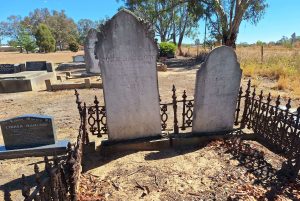
Anna’s children were now aged 15, 13, 11, 9, 7, 4 and 18 months. She was a well known and wealthy lady who may have had no need to remarry. But within months Anna would marry for the third time.
John Hamilton was the sixth child of Scottish immigrants, Matthew and Margaret Hamilton, born in 1860. John was no stranger to heartache himself and it was perhaps a shared tragedy that bonded John and Anna together. Three years prior to his marriage to Anna, John’s mother Margaret took her own life by drowning herself in a dam on the property at Illabo, that she shared with her husband and twelve children. She left no note as to why.
And so it was that Anna, aged 35, twice widowed and a mother of seven, married John Hamilton, a bachelor, aged 25, on the 18th October 1885, 16 months after the death of her children’s father. Both Anna and John listed their address on their marriage certificate as Sandy Creek, a locality near Uranquinty, where Anna’s father Martin lived.
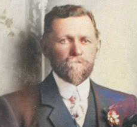
It is unclear from an article in the Albury Banner dated November 1889 if Anna and John became licensees of the Mill Hotel following their marriage or if they were able to purchase it from August Haberecht. The article reads;
JINDERA. More changes in our little village. Mr. Barlow (junior), of the Forest Hotel, has leased his property for a term of years to Mr. Muller of Albury, who I hear takes possession on Tuesday next. Mr. Hamilton has taken up a block of land somewhere in the back country, and intends disposing of his Jindera property, including the Mill Hotel, at an early date.
So John, Anna and some of her younger children left Jindera and moved to a farm at Mitta Mitta, near Junee, which is the area referred to as the ‘back country’ in the notice. The couple would go on to have four children, Isabella May in 1887, John Robert in 1889, Thomas Alfred Bertram in 1891 and Matthew Claude in 1901. Matthew was a late in life baby and probably quite a surprise for 50-year-old Anna. The next fifteen years were a time for family, with Anna enjoying raising her own children and seeing them marry and have children of their own.
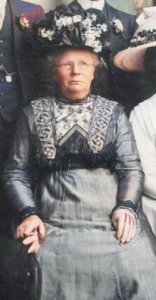
Sadness would be no stranger to Anna though, as she suffered the loss of four of her ten children prior to her own death. Her second youngest son, Thomas Hamilton died in the Great War. Enlisting in April 1916, he was a strong 5ft 8, 24-year-old farm labourer with fair hair and blue eyes. Part of the 17th infantry battalion, he sailed to France in December 1916 and was listed as missing in action just a few months later. A court inquest later confirmed he had been killed on the 3rd May 1917, the first day of the second battle of Bullecourt. It would be a fate for Anna that she shared with so many other women of her generation. Thomas Hamilton’s name is listed on the Villers Bretonneux Memorial in France and on the War Memorial in Canberra, details of which can be found here; Thomas Alfred Bertram Hamilton | Australian War Memorial (awm.gov.au)
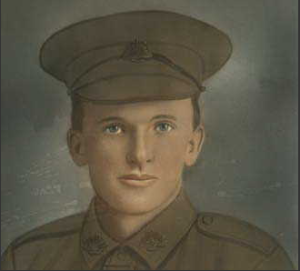
Seven years later, Anna’s eldest daughter Emma, who lived far away in Coonamble, died. After several years in Junee, Anna and John moved to Sydney to be closer to two of their children, Isabella and Matthew. Sadly, Isabella died in 1930 and then five years after that, her eldest son William died. Anna and John lived for many years with son Matthew in Barremma Street, Lakemba. I’ve often wondered what connection my grandfather Charlie had to his great-grandmother Anna. The clue lies with the suburb of Lakemba. Charlie was born in 1912, when Anna was 62 years old. They lived some 500 kilometres apart. However, Charlie’s aunt Annie Perram, Anna’s eldest grand-daughter, born and bred in Coonamble, moved to Sydney with her husband and family, to the suburb of Lakemba. When it came time for Charlie to marry my grandmother Connie, he chose to do so at Jean Perram’s house, Annie’s daughter. Jean and Charlie were first cousins and the great niece and nephew of Matthew Hamilton, Anna’s youngest son. Matthew’s house was half a mile, or a 10 minute walk from the Perram’s house in Taylor Street. With no family stories handed down to our side about Anna, we can only surmise that connections were kept between herself and her daughter Emma’s children, grandchildren and great-grandchildren in Coonamble during her lifetime and beyond, through our knowledge of the Lakemba connection.
John Hamilton died in 1935. Anna would live for another five years, celebrating her 90th birthday in September 1940. However, she developed a chest infection a few weeks later and then pneumonia and passed away.
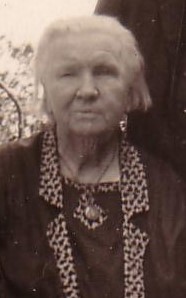
By the time of her death, her children had scattered all over New South Wales and Victoria, from Coonamble to Grenfell and West Wyalong to Wangaratta, Sydney and of course Junee, where Anna and John lived for many years. Her ten children gave her at least 42 grandchildren, with many hundreds alive today. Unfortunately, Anna’s Prussian/German heritage was gone within a generation or two. The majority of her children married people with British surnames. Only the first child Emma and the last, Matthew, married people with discernible German ancestry (Andriske and Neumann). Marriage with non-Germans played a role in the loss of culture, however Australia’s involvement in the two world wars additionally created a separation response within Anna’s descendants, keen to distance themselves from their Germanness.
Through the sharing of Anna’s story, my hope is that a new connection to our German/Prussian heritage can be established. Another great place to start is with a visit to the village of Jindera, a 15 minute drive north of Albury, on the NSW/Victoria border. The town has embraced its German heritage with a magnificent museum precinct and various plaques around town noting important sites, including where the Mill and Forest Hotels stood.
Quite a few years ago, I went to Rookwood Cemetery in search of Anna’s last resting place. I found John Hamilton’s grave, which contained a small headstone, overgrown with weeds. Records state that Anna is buried in the same plot, however her name does not adorn the headstone. It would be lovely to see this remedied by Anna’s descendants and have her life acknowledged in this way.
If you are a descendant reading this, please get in touch with me at stories@quirkycharacters.com.au so that we may find a way to have Anna’s name added to her headstone.
